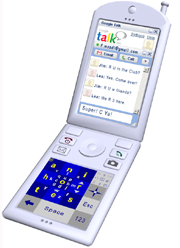The QWERTY keyboard wasn't designed for mobile devices


Credit:www.exideas.com
The selection was rather limited last year for people who wanted to purchase a phone-enabled mobile device with a QWERTY thumb keyboard. You had the ever popular RIM BlackBerry models targeted to the enterprise crowd, the very successful Treo 600 and 650, and some select Pocket PC Phone Edition devices that were used mostly by enthusiasts or those outside the U.S. where the devices were more readily available. That changed significantly in 2006 with the plethora of devices available from several manufacturers. The Motorola Q, Nokia E61/E62, Samsung i320, Sony Ericsson M600i, Nokia P990i, Nokia 9500 Communicator, Treo 700 series, T-Mobile MDA (HTC Wizard), T-Mobile Sidekick 3, HTC TyTN, BlackBerry Pearl, and more. There have also been announcements of new QWERTY devices like the HTC Excalibur, Samsung i600, and Treo 750v. I am personally a fan of the thumb keyboard since it allows me to compose short emails and text messages on the go without having to tap away on the display or with a phone keypad.
While 2006 looks to be the year of the QWERTY keyboard on mobile devices, I wonder if QWERTY really is the most efficient keyboard layout for a mobile device or if there is something better that manufacturers could offer by thinking a bit outside the box. The QWERTY keyboard was designed by C. L. Sholes and patented back in 1878 so I think it is high time we took a look at why this layout keeps appearing on mobile devices. On Pocket PC devices there are numerous soft input panel alternatives, including Fitaly, MessagEase, Spb Fullscreen keyboard, TenGo and many more. I have used Fitaly and MessagEase for quite some time and while there is a rather steep learning curve in the beginning, I have been able to achieve over 50 wpm using these methods. A major reason I can achieve these speeds, with good accuracy, while tapping on the screen is that the keyboards are optimized to minimize stylus movement. Now wouldn't that be cool if they could do the same thing with a thumb keyboard to minimize back and forth movement of your thumbs? This may also reduce the "BlackBerry thumb" strains people are experiencing.
There are also computer keyboard alternatives, such as the Frog Pad and DataHand products. I haven't used either of these keyboards, but I just wanted to show that there are alternatives to the QWERTY keyboard on full size computers as well.
RIM has a modified QWERTY keyboard with their SureType predictive keyboard, found on the BlackBerry 7100 series and Pearl devices, that assigns two letters to each key and I think this is a good move in the right direction. However, it is still using the QWERTY layout. Again, I haven't personally used a device with SureType so I cannot state my opinion or experiences. The problem with adoption of an alternative keyboard for one of these devices is getting users to train themselves on the new layout and embrace the new text input method. People seem fairly comfortable, for the most part, with QWERTY even though everyone of these keyboards on mobile devices differ a bit. I haven't had the same exact experience with every QWERTY thumb keyboard either because space bars are missing, there are different shift keys, alternative characters are accessed or located over different keys, etc. that all result in a bit less productivity as you learn the specific layout for your device.
I would like to see an organization study and then recommend a standard for the mobile device QWERTY keyboard layout so any QWERTY device you pick up would be essentially the same. It would also be extremely useful to have standard shortcuts supported on these keyboards, but I understand that some operating systems may limit this functionality so at least having the layout the same would be helpful.
For mobile enthusiasts like myself (ultimately for everyone who uses a mobile device), I would love to see something like a MessagEase (check out this very interesting research paper) or Fitaly keyboard layout that takes only something like 15 separate keys to implement on a mobile device. Instead of the tap and slide used on touchscreens you could double press or press and hold to enter the different characters and since the keyboard is optimized for the most common letters used you wouldn't have to do this too often. Manufacturers could offer quite a nice form factor device with only 15 keys rather than something like the 39 keys I have on my Nokia E61 keyboard. As long as we are still early in the adoption of keyboards on mobile devices, let's think out of the box and implement some cool solutions rather than going with the traditional keyboard that was designed for ten fingers and a wrist rest.